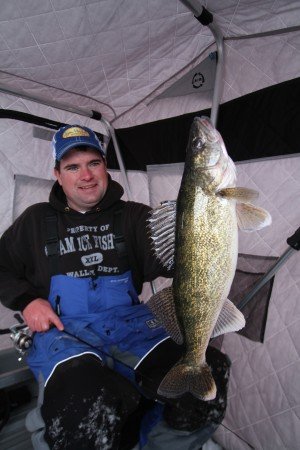 Catching walleye consistently when ice fishing structure, often means finding the point of contact. The edge or structural element that funnels and pinches fish movements when fish move through a particular location causes them to pass through or over a specific location.
Catching walleye consistently when ice fishing structure, often means finding the point of contact. The edge or structural element that funnels and pinches fish movements when fish move through a particular location causes them to pass through or over a specific location.
Amazingly, these fish movements are often very precise. Most of the fish will come through a location passing along the same route often from the same direction.
The beauty of fishing walleye is that they love structure and the fish movements over locations are seldom random. With the accuracy of map chips and lake contours, finding and understanding structure is no longer a guessing game. This makes our ice fishing amazingly accurate.
Walleyes roam to feed during low light periods or after dark.
- On some ice fishing structure, fish will loaf and lay off the structure over the deep structure transition or bottom of the break.
- They slide up on to the structure when they get active.
- This shift or movement when walleyes slide up or through a piece of structure is an opportunity to fish fast over an entire school before they spread out.
- Identify this contact point where walleyes travel and you are on the fast track to catching more walleye this winter.
Hunting walleyes while ice fishing structure.
- To visualize these locations picture a deer stand for bow hunting.
- You know where the deer are bedding and you know the cut alfalfa field that the deer will walk out into after dark.
- Now picture the travel routes and pinch points that deer will use to get from point A to point B… walleyes operate very similarly.
- Both critters are very edge orientated.
Prime times for walleye ice fishing can vary
- On many lakes and reservoirs, this prime time movement is often near or around sunrise and sunset.
- Some bites happen well after dark.
- With that being said, if the fish are moving… you can set up over a good spot and contact fish.
- When the fish are not moving, the only way you are going to catch fish is to keep moving.
This winter has been unique in that we haven’t had a lot of ice. As I write this, we are still hanging on 6 inches of ice in many locations across Devils Lake. What makes this winter different than past winters, besides the fact that we have less ice than most winters, is that the fish have been much spookier.
Banging around or walking around too much will, more often than not, cause the fish to shut down. The best tactic, to catch nice walleyes, is to get to the spot, pick the “x” spot where they travel through and set up over that one hole. Wait out fish movements doing nothing to disturb the spot by excess walking, driving or drilling.
There are times when the fish are oblivious to what is going on above them and there are times when activity seems to stir them up and gets them swimming around where they become catch-able. This winter, walleye have been spookier than normal so the program has been to drill and fish a few holes on a prime spot. Wait out the fish where the activity comes in pulses as schools of fish cruise through.
When walleyes shut down, sitting on the sweet spot becomes crucial. The spook factor can vary from water to water.
- We have seen situations on the river chains for example where anglers used tip ups in four or five feet of water over large sand flats and waited on shore because walking on the ice shut the fish down.
- There have been situations with panfish where the fish wouldn’t swim under an ice shelter and we had to use long rods that went outside the shelter to effectively catch fish.
- On other water, anglers routinely use dead sticks deployed with Arctic Fisherman or tip ups just to spread lines and fish water remotely.
- Every body of water will have its own nuances. Less ice seems to heighten some of these nuances because the ice not only serves as a buffer from human activity above but also enables much more light penetration.
Regardless of ice conditions, however, there is a lesson to be learned.
Spend extra time studing contour maps and learn how walleyes are using that particular piece of structure. The only sure way to really get an understanding of a location is to put in some time on the spot. The key is to identify where the fish lay or spread out when they are inactive and where the fish roam when they become active.
Find the edges and contours between those two locations that walleye follow and ambush them this winter.
By Jason Mitchell
Photo Caption: The author Jason Mitchell with a beautiful walleye. Ambush more walleye this winter by understanding structure and waiting out prime fish movements.